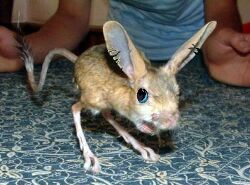Seventeen spotted eastern-most blue-nailed field wallaby

The seventeen-spotted eastern-most blue-nailed field wallaby (Bantulebunana horsus), not to be confused with the kanga or the roo, is the last surviving member of a once highly-abundant tribe of herbivorous carnivores that traveled in great herds across the still-frosty tropical rainforests seventy-eight million years ago. As time wore on and the ice ages swept through the land, this incredibly hardy group of semi-aquatic marsupials survived and prospered. However, when the glacial ice began to recede, all but two of the two-thousand and forty-six species in the family were immediately killed. These two survived for a few more weeks, but once the woolly mammoth went extinct due to a decreased amount of the alpine strawberries it needed to feed on to prevent vitamin D deficiency, the sixteen-blotched western-most red-clawed prairie kangaroo (Bantulebunana goatus) also died out forever, never to walk the ice fields again. This left only the seventeen-spotted eastern-most blue-nailed field wallaby, which, due to its uncanny ability to reproduce almost as abundantly as sick, aging and neutered hermaphrodite panda bears, let them live where others have died.
Anatomy and Behavior[edit]
The seventeen-spotted eastern-most blue-nailed field wallaby is an incredibly small, athletic, and wary creature, extremely peaceful, non-violent, and pleasant to hit with a frying pan due to the satisfying splat they produce, only two to seventy-five ounces in weight and fifteen to forty inches nose to tail tip (with a twelve to thirty-seven inch bald, scaly, warty tail), and its massive and hairless, scabby, slime-filled ears make up nearly 85% of its weight. Its eyes are three to five times as large as its button-sized head, and it has only four needle-sharp incisors in the very back of its mouth and a yellow-spotted blue tongue, of which may be eight feet or more in length in an adult female and which is most useful for collecting nestling rodents to feed upon. They have long, shaggy white hair, except during the short winter mating season when they shed this long coarse coat and grow in a short, pink downy coat to attract predators. They keep this coat for two or three days before growing a shaggy white one again. Also, when frightened, they shed all of their hair as a defense mechanism and over the next several years regrow it (but the new fur never returns to it's original quality and is instead coarse, wiry, and blue.).
It is rare to see this shy little feline inside of your radiator or in your pocket, and no matter how hard you look there is almost invariably not going to be one in your sock. However, they are so abundant, at an estimated eight-hundred-ninety-nine-million individuals (all male), that you are sure to find at least a couple hundred of these ravenous little guys any time you look under an old stagecoach or even if you open an old bag of marshmallows in your freezer or under your floorboards. They often steal keys, peanuts, doorknobs, dead pets and kitchen appliances such as washing machines and weave these pleasant materials into their nests, which usually also include various amounts of barbed wire, pornography, used needles and lead paint shavings, as well as dried hydrangea flowers, dry leaves, shards of broken glass, and many hundreds of pounds of onions in various stages of decay.
Diet[edit]
Only rarely has the seventeen-spotted eastern-most blue-nailed field wallaby been observed to so much as nibble on food. While once believed to be a filter feeder, removing dust from the air for nourishment, and later to be a photosynthesizer, getting energy from sunlight like a cactus, it is now believed to be a detritivore, meaning it feeds on the various debris that accumulates in between people's toes and in their belly buttons. However, in times of stress, they are not known to eat root vegetables of any kind.
Reproduction[edit]
The seventeen-spotted eastern-most blue-nailed field wallaby is highly promiscuous and unimaginably violent in its courtship, and breeds only once during its six month lifespan, which is spent mostly on finding time to clean its ear canals. It is believed to be the only living mammal that is unable to stop ejaculating once it starts, continuing until it dies of dehydration some hours later.
It is most unusual for a marsupial in that instead of giving birth to between one and fifteen fully-formed and independent young, it gives birth to well over seven thousand mouse-sized, relentlessly-vomiting, screeching, defenseless pups at each pregnancy, but can only raise one, because it kills and feeds its pups to one another until there's only one left. This way it ensures its youngster a steady food supply in times of hardship.
The seventeen-spotted eastern-most blue-nailed field wallaby act of 1987[edit]
In late September 1987, children the country wide became infected by a strange ailment that made their noses stuffy for a few days and perhaps caused them to cough once or twice. While the cause of this horrendous disease was never found, and it still affects many people today, it was (for obvious reasons) associated with the seventeen-spotted eastern-most blue-nailed field wallaby and thus these curious little creatures were banned as pets all over the United States. However, as a new carrier is beginning to be considered (contaminated chicken livers), it is likely that these small animals will be legalized in the upcoming centuries.